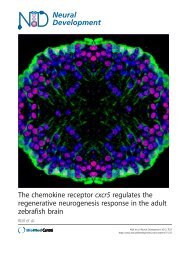Neural Development - BioMed Central
Neural Development - BioMed Central
Neural Development - BioMed Central
Create successful ePaper yourself
Turn your PDF publications into a flip-book with our unique Google optimized e-Paper software.
<strong>Neural</strong> <strong>Development</strong><br />
<strong>BioMed</strong> <strong>Central</strong><br />
Research article<br />
Xenopus NM23-X4 regulates retinal gliogenesis through interaction<br />
with p27Xic1<br />
Toshiaki Mochizuki †1 , Aikaterini Bilitou †1 , Caroline T Waters 1 ,<br />
Kamran Hussain 1 , Massimo Zollo 2 and Shin-ichi Ohnuma* 1,3<br />
Open Access<br />
Address: 1 Hutchison/MRC Research Centre, Department of Oncology, University of Cambridge, Hills Road, Cambridge CB2 0XZ, UK, 2 University<br />
of Biotechnological Sciences, Federico II, Naples, Via Comunale Margherita 482, 80145, Napoli, Italy and 3 UCL Institute of Ophthalmology,<br />
University College London, 11-43 Bath Street, London, EC1V 9EL, UK<br />
Email: Toshiaki Mochizuki - full-moon@umin.ac.jp; Aikaterini Bilitou - ab607@cam.ac.uk; Caroline T Waters - ctw23@cam.ac.uk;<br />
Kamran Hussain - kh306@cam.ac.uk; Massimo Zollo - zollo@ceinge.unina.it; Shin-ichi Ohnuma* - so218@cam.ac.uk<br />
* Corresponding author †Equal contributors<br />
Published: 5 January 2009<br />
<strong>Neural</strong> <strong>Development</strong> 2009, 4:1 doi:10.1186/1749-8104-4-1<br />
Received: 26 October 2007<br />
Accepted: 5 January 2009<br />
This article is available from: http://www.neuraldevelopment.com/content/4/1/1<br />
© 2008 Mochizuki et al.; licensee <strong>BioMed</strong> <strong>Central</strong> Ltd.<br />
This is an open access article distributed under the terms of the Creative Commons Attribution License (http://creativecommons.org/licenses/by/2.0),<br />
which permits unrestricted use, distribution, and reproduction in any medium, provided the original work is properly cited.<br />
Abstract<br />
Background: In Xenopus retinogenesis, p27Xic1, a Xenopus cyclin dependent kinase inhibitor,<br />
functions as a cell fate determinant in both gliogenesis and neurogenesis in a context dependent<br />
manner. This activity is essential for co-ordination of determination and cell cycle regulation.<br />
However, very little is known about the mechanism regulating the context dependent choice<br />
between gliogenesis versus neurogenesis.<br />
Results: We have identified NM23-X4, a NM23 family member, as a binding partner of p27Xic1.<br />
NM23-X4 is expressed at the periphery of the ciliary marginal zone of the Xenopus retina and the<br />
expression overlaps with p27Xic1 at the central side. Our in vivo functional analysis in Xenopus<br />
retina has shown that knockdown of NM23-X4 activates gliogenesis. Furthermore, cooverexpression<br />
of NM23-X4 with p27Xic1 results in the inhibition of p27Xic1-mediated<br />
gliogenesis, through direct interaction of NM23-X4 with the amino-terminal side of p27Xic1. This<br />
inhibitory effect on gliogenesis requires serine-150 and histidine-148, which correspond to the<br />
important residues for the kinase activities of NM23 family members.<br />
Conclusion: This study demonstrates that NM23-X4 functions as an inhibitor of p27Xic1-<br />
mediated gliogenesis in Xenopus retina and suggests that this activity contributes to the proper<br />
spatio-temporal regulation of gliogenesis.<br />
Background<br />
Co-ordination of cell cycle regulation and developmental<br />
signaling is essential for proper development of the nervous<br />
system [1,2]. Recently, it has become clear that developmental<br />
signals can act on cell cycle regulation of neural<br />
progenitors, while cell cycle components can influence<br />
developmental signals. However, little is known about the<br />
detailed mechanisms by which this co-ordination occurs.<br />
The retina is an ideal system to analyze the communication<br />
between cell cycle regulation and cell fate determination.<br />
It consists of six major types of neurons: retinal<br />
ganglion cells – horizontal, amacrine, bipolar, cone and<br />
rod photoreceptor cells; and one glial cell type – Müller<br />
glial cells. All neurons and glial cells are generally produced<br />
from a multipotent pool of retinal stem cells in a<br />
sequentially determined order [3,4]. In the Xenopus retina,<br />
Page 1 of 18<br />
(page number not for citation purposes)




